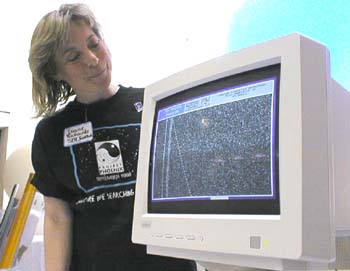![[Metroactive Features]](/features/gifs/feat468.gif)
[ Features Index | Metro | Metroactive Central | Archives ]
Hello Out There?
While SETI scientists wait for a bleep from space, the mind plays tricks
By Jim Rendon
A BLOTCHY PATTERN of black and white squares glows on the face of a computer monitor--a jumbled mess of digital information. "You are an extraterrestrial 25,000 light years from earth. You get a signal transmitted to you, and you need to figure out what it means," says Diane Richardson, looking at the two older men staring at the monitor. "You need to decode the message," she says.
Al McGee, an 87-year-old retired junior high science teacher, and his son-in-law, 79-year-old John Canrio, a former English professor at San Jose State University, eyeball the monitor, hands in pockets. For a moment they are silent under their baseball caps.
"It's mathematical, because math is a more universal language than others," says McGee, taking a stab at the messy picture.
Richardson flashes a smile. She punches in a number on the keyboard and the random patterns begin to change. A stick-figure person, a spiraling crude representation of DNA, a large satellite dish, take form. This, she says, is the message that Carl Sagan and Frank Drake put together to beam into outer space, in case anyone out there is listening for us.
It's the kind of message she hopes will one day find its way to earth from another distant planet.
On the top floor of the Tech Museum of Innovation in San Jose, people walk bleary-eyed from the design-your-own-roller-coaster exhibit, slowing down to take a look at the SETI table. The Search for Extraterrestrial Intelligence Institute, based in Mountain View, has been searching for messages from extraterrestrial life forms since its founder, Richard Drake, first pointed a radio telescope at the sky in 1960. Radio waves, he and other scientists say, are the most efficient way to communicate across the vast expanse of space. And someone might just be out there, trying desperately to get our attention.
But the fact is, no one has responded yet. And the SETI people, presumably to keep themselves occupied while they wait, have begun to fantasize.
Today at the Tech, another SETI monitor displays the kind of radio waves that the organization's astronomers have imagined they might receive.
Peter Backus, a SETI radio astronomer, explains to a small crowd gathered around him what the different patterns on his monitor mean. Tiny black-and-white dots, like TV static, appear in a square. That's random noise, he says. Then three straight vertical white lines cross the screen. Those, he says, originate from earth. But a dotted line off to one side is different. It moves at an angle.
That makes it a good candidate for a message from green men, he says. If SETI astronomers ever received one like that, they would contact another observatory across the planet to see if they could pick up the same signal, making sure it's coming from the same direction.
"That's when we would chill the champagne," Backus says, rubbing his hands together.
The computer system would then send e-mails to astronomers all across the planet, asking them to check the reading as well. If it all fits, and they can't find a man-made source for the transmission, then the fun begins. Like McGee and Canrio, the SETI scientist will have to puzzle over the information, hoping there is an easy key to unlock the alien message.
There have been a handful of false alarms, signals that turned out to be from satellites or spacecraft. No one has yet picked up the long-awaited alien long-distance call.
"If you wake up every day thinking 'Today I'm going to get a signal,' you're going to get frustrated," Backus says. Besides, the institute only gets three weeks of telescope time a year. Most of his time is spent developing software that can detect ever-subtler radio waves, hoping that with a finer net, they will have a better chance of finding a message from the stars.
Even though the Tech's gift shop is full of tiny gray-green figurines with bulbous heads, Backus scoffs at the idea that aliens have already come here, ditching their cosmic crafts in the desert, slipping big companies the secrets to fiber optics and semiconductors.
"That culture and mythology is so self-perpetuating," says Backus of the saucer-believers. "No matter what you say, it feeds on the conspiracy theory. I've had people call me a liar to my face. They get really worked up."
But that doesn't mean that he or other SETI scientists are pessimistic about extraterrestrial life. With the recent discovery of a nearby solar system with multiple planets, he says the odds of life occurring elsewhere are increasing, not decreasing.
As groups of people file past the table, McGee and Canrio look on at the exhibit, debating the possibility of picking up a signal from alien beings. The distance, measured in the amount of time it takes light to travel in a year, seems too vast. Other planets, they say, might be far too old. But McGee is nonetheless optimistic. "Undoubtedly, there is life in outer space," he says.
[ San Jose | Metroactive Central | Archives ]
Copyright © Metro Publishing Inc. Maintained by Boulevards New Media.
![]()

Jim Rendon
From the April 29-May 5, 1999 issue of Metro.